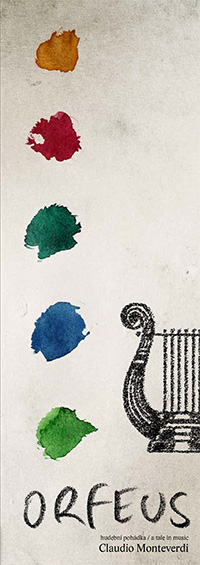Claudio Monteverdi / Alessandro Striggio, Tomáš Hanzlík
Orfeus
Hudební pohádka
/ click the image to download the programme brochure in PDF)

|
Hudba / Music: Claudio Monteverdi Libreto / Libretto: Alessandro Striggio Přebásnění do češtiny: Tomáš Hanzlík
Režie / Stage Director: Tomáš Hanzlík Umělecké nastudování / Rehearsed by: Tomáš Hanzlík & Ensemble Damian Kostýmy a scéna / Costumes and Set: Vendula Johnová Obsazení / Scoring: SSSKTTTBB, vn 1-2, vla, vc, cb, org, theorba, drum, sax
Stopáž / Durata: 60´ |
|

(scroll down for English version)
Jedna z prvních a nejslavnějších oper v novém přebásnění Tomáše Hanzlíka. Kombinuje historicky poučenou praxi s improvizací a alternativními nástroji. Původní partitura je krácena v recitativech, aby měla přístupnější stopáž i pro nezasvěcené a dětské publikum. Inscenace se vrací k původnímu mytologickému konci příběhu, tak jak byla původně zamýšlena i Monteverdim. Inscenačně kombinuje principy barokního divadla, commedie dell´arte a mimoevropských tradičních divadelních postupů.
„Když jsem slyšel už asi dvacátou naprosto odlišnou interpretaci Monteverdiho Orfea a věděl, že partituru instrumentoval i Carl Orff, bylo mi jasné, že je to volný prostor pro realizaci individuálních pojetí. Je to nezničitelná věc a já za ní stále cítil něco jiného, než mi v náznacích skýtaly různé nahrávky i inscenace. Předně: Orfeus byl nový moderní tvar, který slučoval poezii, hudbu a divadlo podle antického vzoru. Co je antické drama a v co se dnes proměnilo? V muzikál. Bohužel ho má v moci jen masová kultura a pop. Jak ale přiblížit tu barokněrenesanční myšlenku dnešku? Možná ty barokní nástroje nejsou to nejdůležitější. Možná je to právě naopak, poučit se maximálně z výdobytků autentiků, ale pak spíš postupovat obráceně - odstranit všechny dobové neaktuální manýry.Tedy: 1. Srozumitelná řeč - čeština bez operní manýry. 2. Pryč s ozdobami. 3. Nově realizovaný generálbas, kombinující historické nástroje s alternativními (ruchovými), větší podíl improvizace v ritornelech.“
Tomáš Hanzlík

English
One of the earliest and most famous operas, Claudio Monteverdi’s L’Orfeo poses numerous and diverse interpretive challenges. Ensemble Damian of Olomouc and its artistic director Tomáš Hanzlík used the printed score from 1607 to prepare a version suiting the poetic temperament of their travelling theatre. As such, L’Orfeo is yet another work in their vast repertoire of operas: Coronide, Endymio, Yta innocens, Torso, Lacrimae Alexandri Magni, Facetum musicum, Water and Air, The World According to Pliny, The Terrible Travesty of the Pregnant Mayor.
The most significant modification of the work involved translating and adapting the Italian libretto by Alessandro Striggio into contemporary Czech. The recitatives from the original score were shortened to create a more concise length, especially for opera neophytes and children. The last change made to the work involved moving the final Moorish dance to after Orpheus’s derogatory song about women. The production thus returns to the original mythological end of the story as was initially intended by Monteverdi. According to the ancient myth, the Bacchantes kill Orpheus, throw his head and lyre into the river, and then carry them to the island of Lesbos which then becomes the birthplace of illustrious poets.
The musical arrangement combines historical instruments with modern and alternative instruments. The visual component offers a blend of the principles of Baroque theater, commedia dell'arte, and contemporary sport movement culture. The Florentine Camerata (a group of intellectuals in late Renaissance Florence) was an important inspiration to Monteverdi and L’Orfeo represents a culmination of the group’s success. Efforts to revive ancient drama led to the creation of a new art form (opera) at the beginning of the seventeenth century. Amateur groups of writers and musicians held parties on the subject of ancient myths. It is very likely that at its premiere in Mantua, L’Orfeo had more of a semi-staged form in which poets and musicians were also singers and instrumentalists, and perhaps even the audience.
